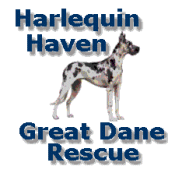|
Hypertrophic Osteodystrophy (HOD)
HOD is typically found in rapidly growing large
breed dogs. From two to six months of age is typical. The breeds that
are most affected are Great Danes, Boxers, German Shepherds, and
Weimaraners.
The clinical signs are fever, anorexia, depression, and lameness which
may vary from mild to severe. Reluctance to stand is very common when
multiple limbs are affected. Lameness may be episodic and most dogs
recover after one episode. The bones most often affected are ends (metaphyseal
regions) of long bones (fore limbs more common than hind limbs). The affected bones are
very painful to touch, and swelling and heat are commonly present over
the affected bones. Other signs that sometimes occur are diarrhea,
discharge from the eyes, tonsillitis, thickening of the foot pads,
pneumonia, and abnormal development of the enamel of the teeth.
The best way to diagnose is an x-ray. A line of lucency where the bone
has been destroyed is usually found to be parallel to the growth plates
of the affected bones. New bone formation in the affected region is
common. Closure of the growth plate usually does not occur.
The microscopic changes are: growth plate is normal, but blood vessels
adjacent to the growth plate are frequently dilated. There also is
bleeding in the bone adjacent to the growth plate as well as extensive
death of the bone adjacent to the growth plate. The line of
lucency seen on x-rays is due to resorption of dead bone. Adjacent to
the line of lucency is a zone of increased density of bone that
corresponds to collapsed of layers of dead bone. The outer layer of the
bone (periosteum) is thickened with new bone formation.
The cause is still currently unknown but some of the proposed causes are
distemper virus infection, vaccination with distemper virus, bacterial
infection, other viral infection, and feeding a high protein and fat
diet to a young pup. Vitamin C deficiency is not likely as dogs make
this vitamin in the liver.
The treatment for HOD is sometimes a very long process as HOD is a
self-limiting disease which can last a few weeks to several months.
Treatment is largely supportive with intravenous fluids, pain
medications, antibiotics if bacterial infection is suspected.
Prognosis is variable. Dogs having mild disease usually have a good
prognosis whereas dogs having severe disease have a poor prognosis.
Permanent skeletal deformity can occur, dogs usually do not die of the
disease but rather are euthanized if recovery is poor or if clinical
signs are severe. Recurrence can be a problem until the dog reaches
maturity.
We recommend all puppies be fed a low protein low fat diet throughout
the first 2 years.
All images and text on this site Copyright © 1998-2025 Harlequin Haven Great Dane Rescue, Inc. unless otherwise credited. Use of any image or text without written permission is expressly forbidden. All rights reserved.
|
|
|
